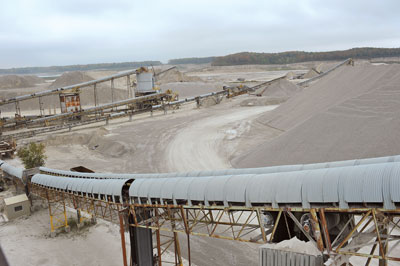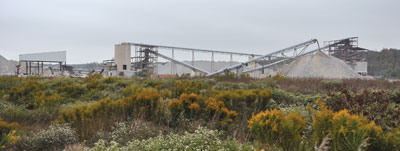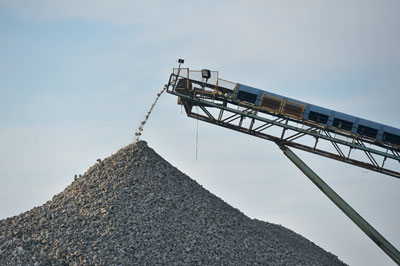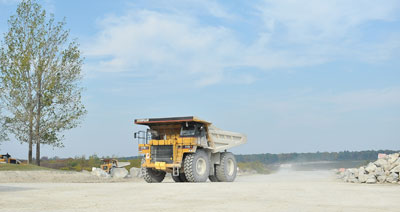
Features
Aggregates
Profiles
Leader of the Pack
When it comes to aggregates, Dufferin sets its sights on the top spot.
October 17, 2011 By Rob Blackstien
On the blackboard in the boardroom of Dufferin Aggregates’ Milton, Ont.,
quarry are scrawled several quotes, the most striking of which is from
Albert Einstein, who wrote: “Insanity: Doing the same thing over and
over and expecting different results.”
On the blackboard in the boardroom of Dufferin Aggregates’ Milton, Ont., quarry are scrawled several quotes, the most striking of which is from Albert Einstein, who wrote: “Insanity: Doing the same thing over and over and expecting different results.”
 |
|
| The Milton quarry, which began operation in 1962, is one of 21 Ontario sites run by Dufferin Aggregates, a division of Holcim (Canada) Inc. |
While quarry personnel claim there is no story behind this quote – at least none they would share with Aggregates & Roadbuilding – it’s clear that if there is in fact any madness at this nearly 50-year-old operation, there is a method behind it, as the Milton quarry’s goal is to be the industry pacesetter in all aspects of its operation.
“Whether it’s production, it’s energy efficiency, it’s corporate social responsibility, it’s rehabilitation, (the quarry’s goal is) to be that industry leader and not be the follower. So set the benchmark,” says site manager Walter Heyden, who has been with parent company Holcim for almost a quarter of a century and has headed this site for over a year.
The Milton quarry, which began operation in 1962, is one of 21 Ontario sites run by Dufferin Aggregates, a division of Holcim (Canada) Inc., which also operates cement, construction and concrete divisions. In turn, Holcim (Canada) is a member of Swiss conglomerate Holcim Group, which has production sites in over 70 countries and employs over 85,000 people across the globe.
 |
|
| The Milton quarry is well planned, both from a design and an execution standpoint. In 1974, the original plant was rehabilitated and Dufferin built a new plant that is partially obscured from the main road. |
The 550-hectare Milton site, located just north of Highway 401 on Ontario’s Niagara Escarpment, is an excellent source of dolomitic limestone (known as the Amabel Formation), which is used to produce an array of construction materials, including concrete stone, asphalt stone, granulars, drainage stone, screenings and landscape stone.
At its peak, Heyden says the quarry shipped over 50,000 tonnes per day, reaching over seven million tonnes annually at its height. Currently, between 25,000 and 30,000 tonnes are shipped daily during the summer construction season and that figure drops to between 7,000 and 10,000 daily tonnes during the winter.
“Most sites have a tonnage limit; this site does not,” says Kevin Mitchell, Holcim Canada’s manager, geology and land development.
Heyden says the Milton quarry has 47 hourly production people and eight salaried people. He estimates the total site staff is around 75, including quality control and dispatch personnel.
The quarry is incredibly well planned, both from a design and an execution standpoint. In 1974, the original plant was rehabilitated and Dufferin built the new plant behind the escarpment, which partially obscured it from the main road.
“Part of the design is that we’re not visible and it also reduces noise for neighbours,” Mitchell explains.
That design extends to the overall extraction plan, as well as the water management system and the rehabilitation of extracted areas. Mitchell says that proper planning of the site is vital because “it’s a very competitive business, so you can only afford to move earth once.”
Mitchell says the Milton quarry has a competitive advantage by being the closest quarry to the populous west side of Toronto, its major market.
“It makes a big difference, when you factor in when you pay for material how much freight is versus how much the product itself is,” he says.
Production Flow
Every winter, stripping is performed for that year’s production campaign, Heyden says. This involves removing the topsoil and overburden, typically using excavators. Last winter, they employed one Cat365L and one Cat330L excavator and also used one Cat 990 and one Cat 998K wheel loader.
Drilling, which is done by Tri-City, involves Furakawa down-the-hole hammer drills that are capable of drilling 4.5-inch-diameter holes up to 80 feet deep, and two Tamrock top hammer drills that can produce 130-foot holes.
Next up comes blasting, also outsourced to a third-party firm (Orica). Using an emulsion mix, the blasting is carefully planned to get rocks just the right size.
 |
|
| : At its peak, the Milton quarry produced over seven million tonnes of product annually. |
“Blasting is the best way to (fracture) rock; however, you don’t want to get too much oversize, nor do you want to get too many fines, and when it falls on the quarry floor, you want to make sure it’s sufficiently sized, but you also want to make sure the pile is “digable.” So the design of the blast factors all of that into it,” Mitchell explains.
Blasting strictly follows Ministry of the Environment regulations, so “it’s not like Wile E. Coyote,” he adds.
Speaking of coyotes, one was spotted during the quarry tour as was a family of skunks and a variety of other wildlife. Site rehabilitation is a huge part of the quarry plans, and the results are already evident. (For more about the Milton quarry rehabilitation and the company’s commitment to environmental issues, please see sidebar on page 12 – “Going Green.”)
The blasted rock is loaded into a fleet of a half-dozen Cat 777 rock trucks by a Cat 998D loader. Chains are kept on the loader’s front tires to increase their lifespan because at the rock face they are running over sharp rock, plus the chains provide more durability during lifting, Mitchell says.
“We utilize the same equipment for stripping, so basically in the first two months of the year, when we’re not producing, that equipment is used for stripping, in conjunction with excavators,” Heyden says.
“Then, once the plant starts producing, they get switched over and utilized for hauling the shot rock from the face of the quarry up to the crusher. That’s roughly a 15-minute cycle time.”
The site’s primary crusher, which is located underground and features a rubberized screen deck to reduce noise, is an Allis Chalmers 5474 gyratory model with a capacity of 2,000 tonnes per hour. Heyden says they are “typically running it in the area of 1,600 to 1,700 tonnes per hour.”
The maximum size of rock the crusher can handle is 36 inches and it will crush pieces down to smaller than eight to 10 inches.
For pieces larger than 36 inches, a 3,500-pound rock hammer is mounted above the crusher to break up the stone.
From there, it gets stored in a surge pile that has a 60,000 tonne capacity based on the height of the stationary incline conveyor.
“From the surge pile, the rock, again via conveyor, gets transported up to the secondary crushing plant,” Heyden says.
It has a set of scalper screens so they scalp off the clear stone. “Basically three inches or greater gets scalped off,” he explains.
 |
|
| One of the Milton quarry’s six Caterpillar 777 rock trucks in action.
|
The clear stone then gets sent to be crushed, and the rest falls through the scalper screen and ends up down in the crusher run screens, or it gets sized smaller again. Basically, Heyden says, everything up to 3/4-inch gets sent again over to classification; anything larger than the maximum size of the screens (which is 15/16-inch) gets sent back to be recrushed.
From there, all the concrete stone gets washed in Wash Plant No. 1, a Simplicity product.
Quality control is a huge part of the process, Mitchell says. “It doesn’t matter what we’re making, there’s a quality assurance process.”
Heyden adds there are two types of samples that get taken. The production sample is taken from a conveyor belt within the processing plant and the quality-control technicians will perform a sim analysis on that and have a quality-control result within a half hour.
“Any adjustments would be made to the process based on that sim analysis,” he says.
Each morning, a shipping sample is also taken just before they are about to load the trucks. The loader operator will dig into the pile and take representative buckets and spread them out on the ground for the QC staff to test them.
“That gives the indication that the product that’s stockpiled is suitable to ship to the customer,” Heyden says.
For loading the trucks in the yard, they have five Caterpillar 980 wheel loaders equipped with load cells. Trucks, which are either customer-owned or arranged for customers by Dufferin through a third party, include tri-axle, tandems, live bottoms, belly dumps and B-Trains.
“Every truck that leaves is scaled out and also has to pass through an automatic wheel wash,” Heyden says.
Mitchell says, depending on the economy, the quarry has a life of another 15 to 20 years.
Going Green
Progressive rehabilitation is a big part of the site plans at Dufferin Aggregates’ Milton, Ont., quarry, says Kevin Mitchell, manager, geology and land development, for Dufferin’s parent company, Holcim (Canada) Inc. So far, over 120 hectares of the site have been rehabilitated, with over 100,000 trees planted and a 70-hectare reservoir built. Once aggregate extraction is completed, over 400 hectares of the rehabilitated lands will be given to Conservation Halton, which is a community-based environmental agency that protects, restores and manages the natural resources in its watershed. This includes a 1,000-square-kilometre landbase with 17 creeks that flow into Lake Ontario, 80 kilometres of Ontario’s Niagara Escarpment and extensive forests. Responsible aggregate production is a huge part of Dufferin Aggregates’ parent Holcim (Canada) Inc.’s corporate philosophy, nowhere more apparent than in Holcim’s participation on the founding board of SERA (Socially and Environmentally Responsible Aggregates). Formed in June, SERA is an independent non-profit organization that’s mission “is to develop world class environmental and social certification standards for the aggregate industry in Canada,” says SERA’s executive director Lorne Johnson. Obtaining SERA certification will be “a means for the most progressive companies to differentiate themselves from the pack, showing that they are meeting international best practices,” Johnson says. “SERA lets aggregate operators show that they have gone above and beyond regulatory requirements to address important social and environmental issues. He explains that the idea for SERA was born out of “growing frustration on the part of both environmental groups and the aggregate industry over the status quo where you’ve got an increasingly litigious environment around new and existing aggregate operations.” Over the years, many aggregate hearings have wound up at the Ontario Municipal Board, at great expense to both sides, Johnson says. “Rather than duking it out in court, SERA brings together both sides to agree to voluntary good practices that cover everything from the siting where aggregate quarries can be located to rehabilitation of closed aggregate sites,” he explains. SERA, which will focus on Ontario to start, has created a draft set of standards for discussion. The next step is to bring the key stakeholders to the table to create a Technical Advisory Group that will help finalize the standards and create standard operating procedures for the sector. This group will include representatives from the aggregate industry, community, municipal government, environmental groups and aboriginal groups, Johnson says. In September, SERA aims to have the group in place and begin developing the operating procedures that will give shape to the standards. This process, which will include finalizing the draft standards, is expected to take 18 months. Ultimately, SERA will create a certification program that is auditable by third-party organizations. Currently, Johnson says one of the challenges SERA faces when speaking to the industry about this “is to convince them that this is just a draft standard and it’s not set in stone. We need industry to know that there is space for them at the table to influence these standards and to make them something they can implement.” |
Rob Blackstien is a freelance writer and the principal of Pen-Ultimate, a Toronto-based writing and editorial services firm.
Print this page